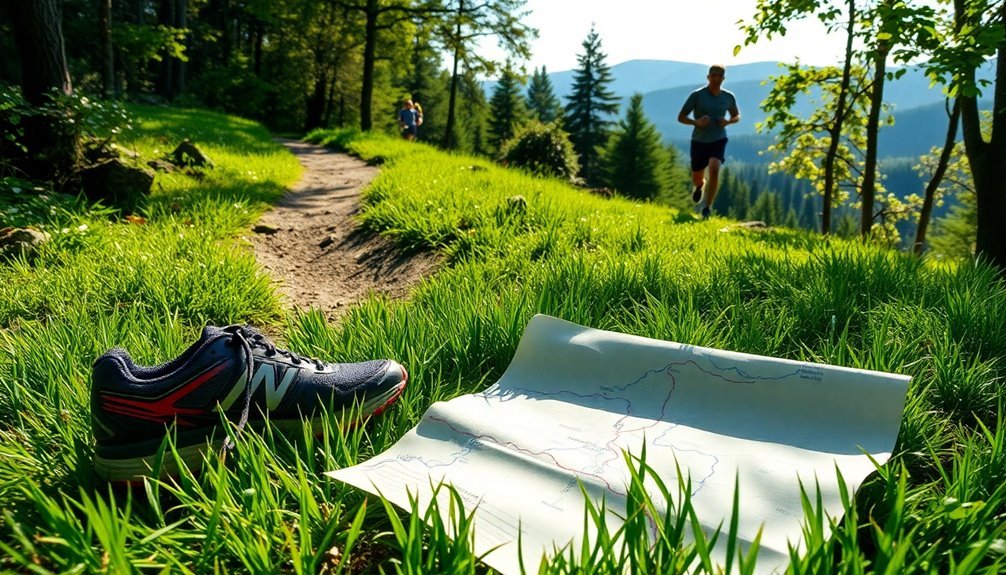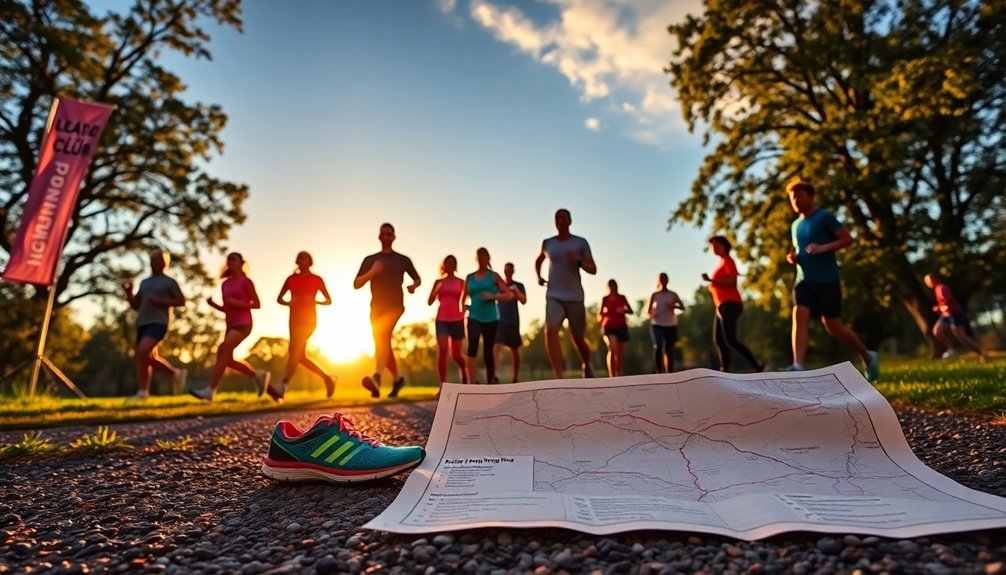Choosing the right running route starts with defining your fitness goals. Consider distance, terrain, and your current fitness level. Beginners should seek flat, shorter paths, while intermediate runners can tackle hills for a challenge. Prioritize safety by avoiding high-traffic areas and familiarizing yourself with local crime stats. Utilize running apps for route planning and connect with local communities for support. With the right route, you'll enhance your routine and achieve your goals, and there's much more to explore.
Key Takeaways
- Assess your fitness level and goals; choose longer routes for endurance or shorter routes for speed.
- Select terrain based on objectives; hilly routes enhance calorie burn, while flat paths boost speed.
- Utilize running apps to find popular routes and gather insights on distances and terrain types.
- Prioritize safety by avoiding high-traffic areas and familiarizing yourself with local crime statistics.
- Incorporate variety in routes to maintain engagement and prevent monotony in your running routine.
The Importance of Selecting the Right Running Route

When you choose the right running route, you set yourself up for success in achieving your fitness goals. The terrain of your selected running routes affects workout intensity and injury risk, so it's essential to pick surfaces that align with your fitness level.
A well-planned route minimizes surprises, ensuring safety and accessibility, especially in urban or rural areas. The time of day also matters; well-lit paths are important for early morning or late-night runs.
Additionally, exploring diverse routes keeps your training fresh and combats boredom, motivating you to stay consistent. By thoughtfully selecting your running routes, you can enhance your overall experience and make meaningful progress toward your fitness goals. Furthermore, incorporating portable camping toilets into your running trips can ensure comfort and convenience during your outdoor adventures.
Key Considerations for Route Planning

Selecting the right running route involves several key considerations that can greatly impact your training experience.
First, determine the distance based on your goals—longer routes build endurance, while shorter ones focus on speed.
Next, choose a time of day that maximizes safety, ideally early mornings or late afternoons to avoid heavy traffic.
When route planning, select terrain that matches your objectives: hilly paths for calorie burn or flat surfaces for speed.
Assess the route's difficulty to guarantee it aligns with your fitness level, progressively challenging yourself without risking injury.
Finally, incorporate variety in your local running to keep things fresh and engaging, exploring different environments and terrains to maintain motivation and enjoyment.
Aligning Your Route With Your Running Goals

When you're setting your running goals, it's essential to choose routes that match those objectives.
If you want to build endurance, opt for longer distances that push your limits.
For specific races, picking terrain similar to the event can give you the best preparation possible.
Goal-Specific Terrain Selection
To maximize your training effectiveness, aligning your running route with specific goals is essential. If you're looking to build strength and endurance, hilly terrain can considerably enhance your workouts.
On the other hand, if speed and pace are your goals, flat, smooth surfaces allow for better time tracking and performance improvement. Incorporating varied terrains, like trails or sand, challenges different muscle groups and contributes to a balanced training regimen.
If you're preparing for a marathon, choose routes that mimic the race terrain, ensuring you're ready for race day conditions.
Don't forget to utilize local resources, like running clubs or apps, to discover routes that align with your desired terrain and training goals, keeping you engaged and motivated.
Distance and Endurance Planning
Mapping out your running route requires careful thought about the distance you want to cover, especially as it relates to your fitness level and goals.
If you're training for a race or looking to improve your endurance, start by determining a distance that challenges you without overexerting. Gradually increase this distance to build endurance and help your body adapt, minimizing injury risk.
Consider incorporating varied terrain—like hills or flat paths—to enhance your strength and calorie burn. Out-and-back routes are great for tracking distance and pacing, ensuring you have a clear return point.
Finally, use running apps to monitor your distance progression, keeping you motivated and aligned with your endurance goals.
Safety First: Ensuring a Secure Running Experience

Ensuring your safety while running is essential, especially in unfamiliar areas. Always prioritize routes that avoid high-traffic zones and minimize road crossings; this reduces your risk of accidents and injuries.
Choose well-lit paths, particularly for early morning or evening runs, to enhance visibility and keep you safe. Familiarize yourself with local crime statistics and select routes in safer neighborhoods to bolster your personal security.
Stick to familiar trails to decrease the chance of getting lost and help you navigate potential hazards. Additionally, use running apps that offer safety features, like route sharing with friends and live tracking, to enhance your security while running alone.
Terrain Types and Their Impact on Your Workout

When you choose your running route, the type of terrain can greatly influence your workout's effectiveness and your overall experience.
Flat terrain, like roads or tracks, is perfect for speed training, allowing you to focus on improving your pace with consistent footing.
On the other hand, hilly routes can ramp up your cardiovascular fitness and strength, as the effort required to ascend builds endurance.
Trail running on uneven surfaces enhances balance, engaging different muscle groups for a functional workout.
Soft surfaces, such as grass or dirt, are easier on your joints, making them ideal for recovery runs.
Finally, varied terrain types, including sand or gravel, can boost calorie burn and challenge your body, maximizing the impact on your workout.
Using Technology for Effective Route Planning

When it comes to planning your running route, technology can be a game-changer.
You can use tools like Google Maps and running apps to create customized paths, discover popular routes, and even find out about local terrain.
Plus, engaging with online communities can lead you to new trails and insights from fellow runners.
Route Mapping Tools
Utilizing technology can greatly enhance your running route planning, making it easier to find paths that suit your preferences and training goals.
With various route mapping tools at your disposal, you can tailor your running experience effectively. Here are three useful options:
- Google Maps: Trace desired routes, estimate distances, and view terrain types for informed decisions.
- Komoot: Enter starting and ending points to get surface information and elevation details, perfect for specific training needs.
- MapMyRun: Calculate route distances and discover popular paths based on user-generated data.
Utilizing Running Apps
How can running apps transform your training experience? These tools are game-changers for route planning.
Apps like Strava and Runkeeper help you discover popular local routes, providing insights into terrain, elevation, and distance preferences. You can use Google Maps to create custom paths, allowing you to visualize your route and estimate distances before you head out.
Komoot even offers tailored route suggestions based on your starting and ending points, ensuring you find suitable terrain for your training needs. Plus, many running apps let you save favorite routes and track your progress, boosting consistency and motivation. Additionally, utilizing these apps can help you set specific savings goals for your fitness journey, similar to how budgeting aids in financial health.
With these features, you're not just running; you're running smarter and more effectively towards your fitness goals.
Online Community Resources
While you're planning your next running route, tapping into online community resources can elevate your experience. These platforms not only help you find popular paths but also connect you with fellow runners.
Here are three ways to utilize these resources effectively:
- Explore local routes on platforms like Strava and MapMyRun, where you can see insights on distance, terrain, and safety.
- Customize your paths using Google Maps, which lets you estimate distances and identify points of interest along the way.
- Engage with social media communities through hashtags and location tags, making it easier to discover new routes and receive valuable advice. Additionally, consider checking air quality considerations as they can impact your running experience and help you choose the best times to run outdoors.
Exploring New Areas: The Benefits of Runsploring

When you venture out to explore new areas while running—often referred to as runsploring—you reveal a world of unique neighborhoods, parks, and scenic spots that can transform your workout into an adventure.
This practice keeps your runs fresh and invigorating, making it easier to stay committed to your routine. As you navigate different terrains, you challenge your body in new ways, which can promote better fitness and reduce the risk of overuse injuries from repetitive routes.
Plus, you might stumble upon local attractions, art installations, or hidden cafes that add unexpected joy to your runs.
Engaging With Local Running Communities

Engaging with local running communities can greatly enhance your running experience, as you'll find motivation and camaraderie among fellow enthusiasts.
By joining running clubs, you'll access organized group runs that keep you inspired and connected.
Here are three ways to immerse yourself in your local running scene:
- Join a running club: Connect with others who share your goals and discover new safe running routes.
- Follow hashtags on social media: Use tags like #denverrunners to find local groups and discussions about routes and experiences.
- Participate in community events: Engage in fun runs or charity races to meet fellow runners and explore hidden gems in your area.
These connections can provide invaluable insights, making your runs more enjoyable and secure.
Mental Engagement: Keeping Your Runs Interesting

To keep your runs interesting, focus on mental engagement by exploring varied terrains like trails and hills. These environments provide visual stimulation, preventing the monotony that often comes with repetitive routes.
Incorporating interesting landmarks into your runs can also boost your motivation, making each outing feel fresh and exciting. Change up your routes frequently to keep the routine dynamic and avoid feelings of stagnation.
Utilize apps or maps to discover new areas, and don't hesitate to join community events that introduce you to new paths. Additionally, engaging with local running clubs can help you tap into the importance of networking for motivation and support.
With these strategies, you'll not only improve your performance but also enjoy your running journey more.
Adapting Your Route to Fit Your Fitness Level

To adapt your running route to fit your fitness level, start by evaluating your current abilities, including your pace and endurance.
This way, you can choose a route that challenges you appropriately while minimizing the risk of injury.
Remember to gradually increase your distance, sticking to manageable increments to help build your stamina over time.
Assess Current Fitness Level
Evaluating your current fitness level is crucial for choosing the right running route. To effectively assess your current fitness level, consider these factors:
- Recent Distances: Review how far you've been running recently to gauge your endurance.
- Pace: Check your average pace to understand your speed and adjust your goals accordingly.
- Terrain Preference: Identify whether you prefer flat routes or enjoy the challenge of hills.
As you plan your running, remember that beginners should start with flat, even terrain and shorter distances. Intermediate runners can mix in hills or trails, while advanced runners should target routes that align with specific training goals. Additionally, regularly evaluating your fitness will help you keep progressing and prevent plateauing, just as user consent management is important for maintaining control over your personal data.
Gradual Progression in Distance
As you adapt your running route to fit your fitness level, gradually increasing your distance is key to building endurance without risking injury. A common approach is to increase your distance by 10% each week. Start with shorter routes that match your current endurance, and vary your terrain to challenge your body. Use apps like Strava to track your progress and plan routes that allow for incremental distance increases. Confirm your routes have accessible turnaround points for easy adjustments. Additionally, maintaining a clean home environment can support your overall wellness and enhance your running performance.
| Week | Distance (miles) | Notes |
|---|---|---|
| 1 | 3 | Start with easy pace |
| 2 | 3.3 | Add a hill |
| 3 | 3.6 | Incorporate loops |
This gradual progression will help you meet your running goals effectively.
Frequently Asked Questions
How to Choose a Running Goal?
To choose a running goal, start by reflecting on your current fitness level and experience.
Think about what excites you, whether it's distance milestones, races, or unique challenges.
Assess your motivation—do you prefer short-term goals or long-term commitments?
Also, consider your personal responsibilities and time availability to guarantee your goals are realistic.
Engage with the running community for support and insights, which can help you stay motivated and focused on your aspirations.
What Is a Good Running Route?
Choosing a good running route is like picking the perfect canvas for your masterpiece. You want a path that's safe, well-lit, and free from heavy traffic, especially during early runs.
Consider your goals: if you're training for a marathon, select a route that challenges you with varied terrain. Scenic views can spark your motivation, while flexibility in distance keeps your workouts fresh and adaptable.
Enjoy the journey, and let each run invigorate your spirit!
Is There an App That Will Plan a Running Route?
Yes, there are several apps that can help you plan a running route.
Strava and MapMyRun let you customize routes based on your starting point, distance, and terrain preferences.
Google Maps can help you trace and estimate distances for your runs.
Runkeeper offers popular crowd-sourced routes, while Komoot gives detailed surface information.
For offline access, apps like OS Maps and Plotaroute.com can guarantee you've got your planned routes handy, even without cell coverage.
How to Find Your Best Running Distance?
To find your best running distance, start by identifying your specific goals, like building endurance or improving speed.
Gradually increase your mileage using the 10% rule to avoid injuries.
Mix up your running distances throughout the week, incorporating recovery runs and speed workouts.
Use apps or GPS devices to track your progress and listen to your body—adjust your distance based on how you feel, considering factors like fatigue and terrain.
Conclusion
Choosing the right running route isn't just about the distance or pace; it's almost like a science experiment where you're the subject and the results are your fitness goals. So, while you might think wandering aimlessly through the same old park is enough, remember that variety is the spice of life—and your workout! Embrace the unexpected, connect with fellow runners, and watch your motivation soar. After all, even the most seasoned runners need a little adventure now and then.









